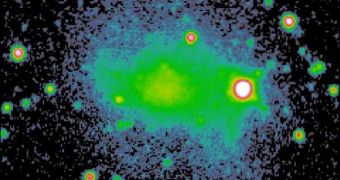When the Universe was just a fraction of its current age, and galaxies such as the one we inhabit were nowhere to be seen, stars formed inside peculiar structures, that have long since disappeared. But astronomer Deidre Hunter, who is based at the Lowell Observatory, has spent more than 17 years studying one of the classes of existing objects that may provide clues as to how stars appeared shortly after the Big Bang. These structures are called dwarf irregulars, and the scientist believes that the peculiar type of stellar formation processes they display may resemble the original one.
Unlike massive galaxies, such as the Milky Way, with highly-defined central regions, spiral arms and so on, dwarf irregulars are very small and diffuse groups of stars, which are the last thing to spring to mind when thinking of the word “galaxy”. “Star formation in dwarfs today is similar to star formation right after the Big Bang. Stars form out of clouds of gas. Our quest is to figure out what the molecular clouds in these irregular galaxies are, and the processes that form stars,” Hunter explains, quoted by LiveScience.
This work is being carried out under a grant from the US National Science Foundation (NSF), and the investigation is called LITTLE THINGS – which stands for Local Irregulars That Trace Luminosity Extremes (LITTLE), and The HI Nearby Galaxy Survey (THINGS). The goal of the study is to determine the chemical composition of gases that can still be found inside these peculiar types of galaxies. Drawing parallels between this data and what is currently known of the make-up of the Universe in the first time epochs after the Big bang could provide us with more clues as to the conditions that favored the emergence of the first stars.
There are numerous things to consider when analyzing stellar formation, the expert says. For once, not only the amounts and masses of hydrogen gas inside a stellar nursery are important, but also their motions. “It's not just density, but also the motions of the gas,” Hunter explains. “The crux of the problem is that the standard models for galaxies don't work for dwarfs. Dwarfs should not be forming stars at all,” she adds. Generally, in average galaxies, ares of stellar formation are concentrated more towards the core, and seldom at the outskirts of the space structures. “It's the outer disks – because they are so extreme. These are such extreme environments that they are very stringent tests for star formation,” the expert concludes.

 14 DAY TRIAL //
14 DAY TRIAL //